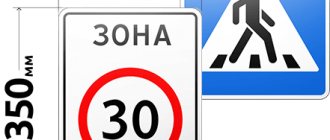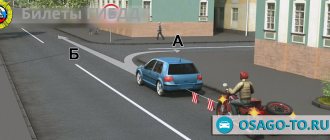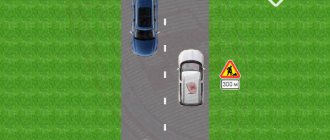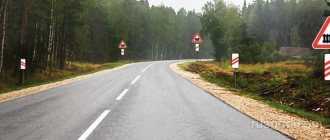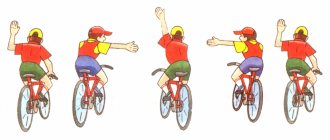Signs 5.16 - 5.18 “Bus (trolleybus), tram and taxi stop”
Signs 5.16 “Bus and (or) trolleybus stopping place”, 5.17 “Tram stopping place” and 5.18 “Taxi parking place” are used to designate stopping points of the corresponding types of route vehicles and passenger taxi parking.
Signs 5.16 “Bus and (or) trolleybus stopping place” are installed at the beginning of the landing area.
If there is a pavilion at a stopping point, then the stop sign can be installed on the pavilion above its closest edge in the direction of travel or on a separate support next to the pavilion.
When it is necessary to indicate the length of one or several stopping points located one after another, sign 5.16 “Bus and (or) trolleybus stopping place” is used with sign 8.2.1 “Validity area”. The sign is installed at the beginning of the first stopping point.
When tram tracks are located in the middle of the roadway (or to the left of a one-way roadway), sign 5.17 “Tram stopping place” is installed to the right of the roadway.
In some cases, when tram tracks are located in the middle of the roadway, the “Tram Stopping Place” sign is duplicated. Duplicate sign 5.17 is installed:
- if there is a raised landing area along the tram tracks - at the beginning of this area;
- on roads with two or more lanes in a given direction, if there is no landing pad - above the left lane.
It must be remembered that stopping or parking is prohibited closer than 15 meters from the stops of route vehicles or the parking of passenger taxis (clause 12.4 of the traffic rules). The starting point is the place where signs 5.16 - 5.18 are installed. This means 15 meters before and 15 meters after these signs, stopping and parking is prohibited.
Stopping is prohibited for any reason (except for stopping to pick up or disembark passengers, provided that this stop does not interfere with the movement of route vehicles or passenger taxis).
In places where route vehicles stop, turning around is still prohibited (clause 8.11 of the traffic rules).
The length of the route vehicle stop and taxi rank can be indicated by marking 1.17 (yellow zigzag). In this case, the prohibition on stopping (parking) and turning around applies throughout the entire yellow marking 1.17.
In populated areas, when driving past designated stops of route vehicles, you must also remember that clause 18.3 of the traffic rules obliges you to give way to trolleybuses and buses starting from the stop.
The issue of priority between route vehicles and other “non-route” traffic participants is discussed in the articles Driving past a stop of route vehicles and Priority of public transport.
Tram stop sign
The road sign “Tram stopping place” is installed on the road in the following cases:
- To the right of the roadway if the tram tracks run in the middle of the road.
- To the right of the carriageway on a one-way road, if the tram tracks are located to the left of the road.
In addition, a duplicate sign is installed either at the beginning of a raised landing area above the roadway, or above the left lane of a given direction (on roads with 2 or more lanes for traffic in a given direction).
Please note that the “Tram Stopping Place” sign is installed on the roads in order to help the driver comply with the requirements of paragraph 14.6 of the rules:
14.6. The driver must give way to pedestrians walking to or from a fixed-route vehicle standing at the stopping place (from the door side), if boarding and disembarking is carried out from the roadway or from a landing area located on it.
For violating this clause of the rules, the driver will receive a fine of 1,500 rubles.
Signs 5.19.1, 5.19.2 “Pedestrian crossing”
Signs 5.19.1 and 5.19.2 “Pedestrian crossing” are used to designate places intended for pedestrians to cross the road.
Sign 5.19.1 is installed on the right of the road, sign 5.19.2 on the left. On roads with a dividing strip (lanes), signs 5.19.1 and 5.19.2 are installed on the dividing strip, respectively, to the right or left of each roadway.
Sign 5.19.1, which is installed to the right of the road, is placed on the near border of the crossing relative to approaching vehicles, sign 5.19.2 - on the far one. The width of the pedestrian crossing, incl. which does not have zebra markings, is located between the lines on which the signs are installed.
Signs at a marked pedestrian crossing (markings 1.14.1, 1.14.2) are installed at a distance of no more than 1 meter from the boundaries of the crossing (from the markings).
At intersections it happens that the border of the marked (zebra) crossing closest to the center of the intersection coincides with the edge of the roadway. In other words, the pedestrian crossing seems to go beyond the border of the intersection or pass along its edge.
In this case, “Pedestrian crossing” signs may be installed only at the far border of the crossing, i.e. at the entrance to the intersection. The transition boundary is determined by the edge of the applied marking 1.14.1 or 1.14.2 (zebra).
Turning, stopping and parking of vehicles is prohibited at pedestrian crossings.
It is not prohibited to make a U-turn before or after a pedestrian crossing, unless there are other restrictions for this maneuver (for example, a solid center line marking).
Stopping and parking of vehicles is also prohibited within 5 meters of a pedestrian crossing. Immediately after the crossing, this ban is lifted unless there are other restrictions for it (for example, signs prohibiting stopping or parking are installed).
Pedestrian crossing sign
A pedestrian crossing road sign is used to indicate the boundaries of a pedestrian crossing if there are no corresponding markings on the road:
Please note that there are 2 different pedestrian crossing signs (5.19.1 - on it the pedestrian goes to the left, and 5.19.2 - on it the pedestrian goes to the right). The first sign is installed on the right side of the road, and the second, respectively, on the left. In this case (in the absence of road markings), signs are used to mark the boundaries of the pedestrian crossing.
I would like to draw your attention to the fact that in practice, pedestrian crossing signs on different sides of the road are sometimes installed strictly opposite each other, i.e. it turns out that the beginning of the transition coincides with its end. Naturally, a pedestrian cannot move around such a structure without violating the rules, and in some cases this can be used to their advantage.
Among the features of the installation of this sign, it should be noted that on roads with a dividing strip, pedestrian crossing signs are installed on each of the roadways separately. Those. one sign on each side of each roadway.
Let me remind you that the coverage area of a pedestrian crossing is determined by the following criteria:
- According to the markings, if any.
- According to signs 5.19.1 (start) and 5.19.2 (end), if there are no markings.
Currently, pedestrians have priority when crossing the road at unregulated crossings. If the driver does not allow the pedestrian to pass in time, he will receive a fine of 1,500 rubles.
In addition, turning around (clause 8.11 of the traffic rules) and reversing (clause 8.12 of the traffic rules) are prohibited at pedestrian crossings. The fine for these violations is provided for in Part 2 of Article 12.14 of the Code of Administrative Offenses and amounts to 500 rubles.
Sign 5.20 “Artificial hump”
Sign 5.20 “Artificial Roughness” is used to indicate the boundaries of an artificial roughness.
The sign is installed on the nearest border of an artificial hump or marking 1.25 (indicating a road unevenness) relative to approaching vehicles.
Often, together with sign 5.20, you can see the prohibitory sign 3.24 “Maximum speed limit”. The coverage area of sign 3.24 does NOT end beyond the road bump.
Usually in such cases (next to the artificial bump), the speed limit sign is installed together with plate 8.2.1 “Validity area”, which indicates the coverage area of the prohibition sign.
If sign 3.24 “Maximum speed limit”, installed next to an artificial hump, is used without sign 8.2.1 “Value area”, then its coverage area lasts until the nearest intersection, or to another sign 3.24 with a different speed value.
An artificial unevenness is, after all, a bump, albeit of artificial origin. It can be large or small in size (there is a standard, but it may not be followed). In any case, driving over any unevenness, we can safely say that the car’s suspension is “strained.” To learn how not to damage your suspension, see the article How to drive over road bumps.
A little about tram stops: nn4people — LiveJournal
I won’t say anything new that stopping a tram on a combined track in the middle of the roadway is a great evil, both for passengers and motorists. A typical stop in the city now looks like this
There are no signs or markings here. Firstly, it is simply dangerous, because... It is simply impossible for drivers to visually determine where the tram stops. Secondly: there can be no talk of any comfort for passengers. Such stops create chaos on the road and generate congestion. The problem must be solved somehow.
An ideal stop in the middle of the roadway should look like this: a raised platform, fencing, a covered pavilion and an adequate pedestrian crossing, ideally controlled.
Examples from other Russian cities
Joburg
Peter
Perm is, in my opinion, the best Russian implementation
Well, or if there is no room for a platform, then at least this:
Obviously, we don’t have anything close to this, but there are enough stops on a six- to four-lane road. Just look at Belinsky Street.
The trouble is that building a platform is very expensive and requires a separate tram line and a fairly large-scale reworking of the entire road space and traffic changes. All this is not easy and takes a long time. However, security needs to be improved.
At a minimum you need this:
1-Main stop sign (now there isn’t even one) 2-Duplicate for 2 or more lanes in one direction (not counting paths) 3-Marking
This approach, oddly enough, according to GOST, is why the following letter was sent to the Department of Transport:
In accordance with the Decree of the Nizhny Novgorod Administration No. 4631 dated December 26, 2006, as well as in accordance with the “Regulations on the Department of Transport and Communications of the Nizhny Novgorod City Administration,” the Department is responsible for the technical means of organizing traffic in the regional center (traffic lights, signs , markings and fencing). In accordance with paragraph 5.6.23 of GOST R 52289-2004, at tram stops if there are tram tracks in the middle of the roadway, signs 5.17 'Tram stopping place' must be installed to the right of the roadway when tram tracks are located in the middle of the roadway or to the left of the one-way roadway movement, as well as in some cases also duplicate signs. Also, in accordance with paragraph 6.2.20 of GOST R 52289-2004, yellow markings 1.17 must be applied at tram stops “to indicate stops of route vehicles and parking for passenger taxis,” since according to the traffic rules, a tram is a route vehicle. However, in the city of Nizhny Novgorod, at most tram stops when the tram tracks are located in the middle of the roadway, in violation of GOST R 52289-2004, signs 5.17 'Tram stopping place' are missing on both sides of the roadway. Also, despite the fact that 1.17 markings are regularly applied in the city to indicate bus and trolleybus stops, 1.17 markings are always absent at all tram stops, in particular when tram tracks are located in the middle of the roadway. In cases where a tram stop is combined with a bus or trolleybus stop, marking 1.17 is applied in violation of GOST R 52289-2004, namely “The length of the marking is determined taking into account the number of simultaneously stopping or standing vehicles, but not less than the length of the landing area.”, while the length The markings at such stops are much shorter than the length of two-car CME trams. An approximate list of tram stops that are not marked in any way on the roadway or are marked with violations: all stops on Ilyinskaya St., “Dobrolyubova”, “B. Pokrovskaya”, “Cherny Pond”, “River School”, all stops on B. Pecherskaya St. , all stops on Belinsky Street, all stops on Osharskaya Street, all stops on Oktyabrskaya Revolution Street, on Chkalov Street, Moskovsky Station stop, on Kirov Avenue, on Vozhdei Revolution Street, etc. This situation leads to the fact that tram stops are often not marked at all on the roadway. As a consequence, this leads to emergency situations and conflict situations on the roads in the areas of tram stops and combined stops, because It is very often simply impossible for drivers to visually determine the presence and location of a tram stop, and there are also frequent cases of illegal parking of cars directly in the stop area, which also directly affects the safety of public transport passengers. In connection with the above, I ask: 1) to carry out an investigation into this fact; 2) to ensure compliance with GOST R 52289-2004 by installing signs 5.17 'Tram stopping place' at those tram stops where they are not available, as well as applying markings 1.17 at tram stopping places . 3) Respond to this appeal in writing, within the period established by law.
What was the answer to?
Well, we’ll check the implementation within a year. Experience shows that installation of a sign can take up to 6 months.
nn4people.livejournal.com
Signs 5.21 “Residential zone” and 5.22 “End of residential zone”
Sign 5.21 “Residential zone” is used to designate the territory (zone) within which the requirements of the Road Traffic Rules, which establish the procedure for traffic in residential zones, apply. Sign 5.21 is installed at all entrances to residential areas.
Sign 5.22 “End of residential area” is used, accordingly, to indicate the end of a residential area. The sign is installed at all exits from residential areas. It may be placed on the reverse side of sign 5.21.
The rules for driving in courtyards and in areas marked with “Residential Zone” signs can be found in the article Driving in courtyards and residential areas from the Basics of Safe Driving series.
A complete list of road signs with special requirements with brief comments (explanations) on the website is posted in Appendix 1 of the Traffic Regulations.
Navigation through a series of articles<< Signs “Start of lane” and “End of lane” Signs Beginning and End of a populated area >>
Stop sign
The sign is installed to increase awareness among drivers and passengers. There are certain numbers on the tram stop road sign - 5.17. For such stops, slightly different traffic rules apply. This applies to traffic rules for passing tram stops. The fact is that the tram can stop right in the middle of the street, which is used for car traffic. In this case, a yellow zigzag line is drawn on the road near the tracks. It stipulates that the driver, if a tram with passengers stops, must wait until they get off and cross the road, and only then the car can move on.
However, it may move slowly if people are not walking, but it will be safer to wait until the passenger drop-off/pick-up process is complete.
The remaining rules are the same as for other public transport stops.

